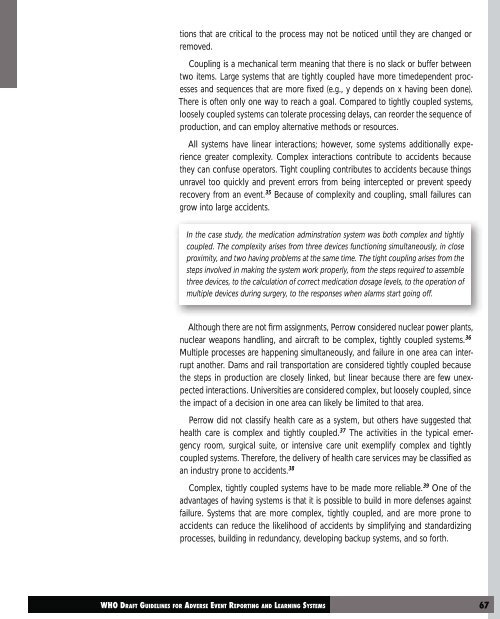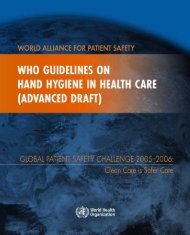Adverse event reporting.pdf
Adverse event reporting.pdf
Adverse event reporting.pdf
You also want an ePaper? Increase the reach of your titles
YUMPU automatically turns print PDFs into web optimized ePapers that Google loves.
tions that are critical to the process may not be noticed until they are changed or<br />
removed.<br />
Coupling is a mechanical term meaning that there is no slack or buffer between<br />
two items. Large systems that are tightly coupled have more timedependent processes<br />
and sequences that are more fixed (e.g., y depends on x having been done).<br />
There is often only one way to reach a goal. Compared to tightly coupled systems,<br />
loosely coupled systems can tolerate processing delays, can reorder the sequence of<br />
production, and can employ alternative methods or resources.<br />
All systems have linear interactions; however, some systems additionally experience<br />
greater complexity. Complex interactions contribute to accidents because<br />
they can confuse operators. Tight coupling contributes to accidents because things<br />
unravel too quickly and pr<strong>event</strong> errors from being intercepted or pr<strong>event</strong> speedy<br />
recovery from an <strong>event</strong>. 35 Because of complexity and coupling, small failures can<br />
grow into large accidents.<br />
In the case study, the medication adminstration system was both complex and tightly<br />
coupled. The complexity arises from three devices functioning simultaneously, in close<br />
proximity, and two having problems at the same time. The tight coupling arises from the<br />
steps involved in making the system work properly, from the steps required to assemble<br />
three devices, to the calculation of correct medication dosage levels, to the operation of<br />
multiple devices during surgery, to the responses when alarms start going off.<br />
Although there are not firm assignments, Perrow considered nuclear power plants,<br />
nuclear weapons handling, and aircraft to be complex, tightly coupled systems. 36<br />
Multiple processes are happening simultaneously, and failure in one area can interrupt<br />
another. Dams and rail transportation are considered tightly coupled because<br />
the steps in production are closely linked, but linear because there are few unexpected<br />
interactions. Universities are considered complex, but loosely coupled, since<br />
the impact of a decision in one area can likely be limited to that area.<br />
Perrow did not classify health care as a system, but others have suggested that<br />
health care is complex and tightly coupled. 37 The activities in the typical emergency<br />
room, surgical suite, or intensive care unit exemplify complex and tightly<br />
coupled systems. Therefore, the delivery of health care services may be classified as<br />
an industry prone to accidents. 38<br />
Complex, tightly coupled systems have to be made more reliable. 39 One of the<br />
advantages of having systems is that it is possible to build in more defenses against<br />
failure. Systems that are more complex, tightly coupled, and are more prone to<br />
accidents can reduce the likelihood of accidents by simplifying and standardizing<br />
processes, building in redundancy, developing backup systems, and so forth.
















